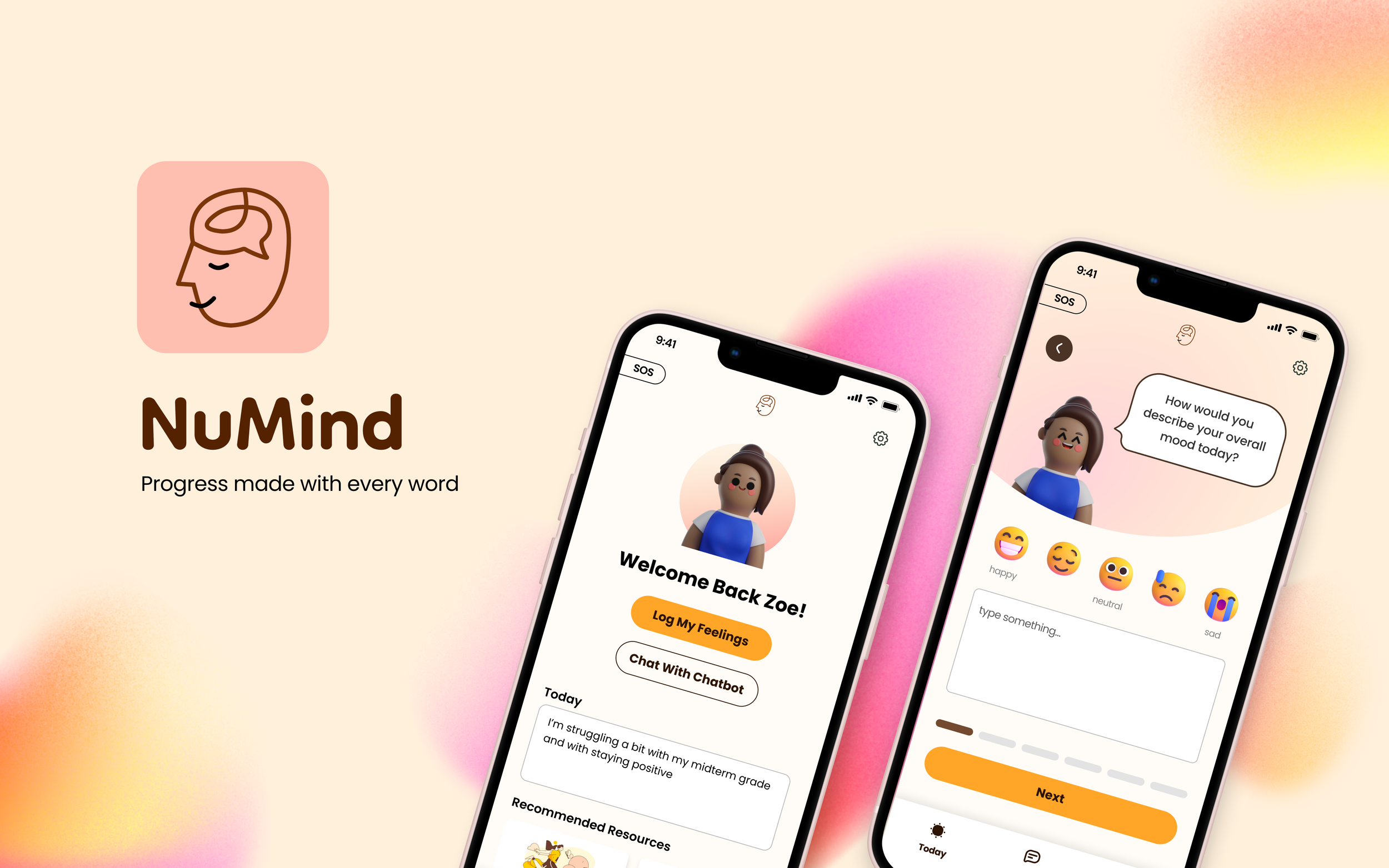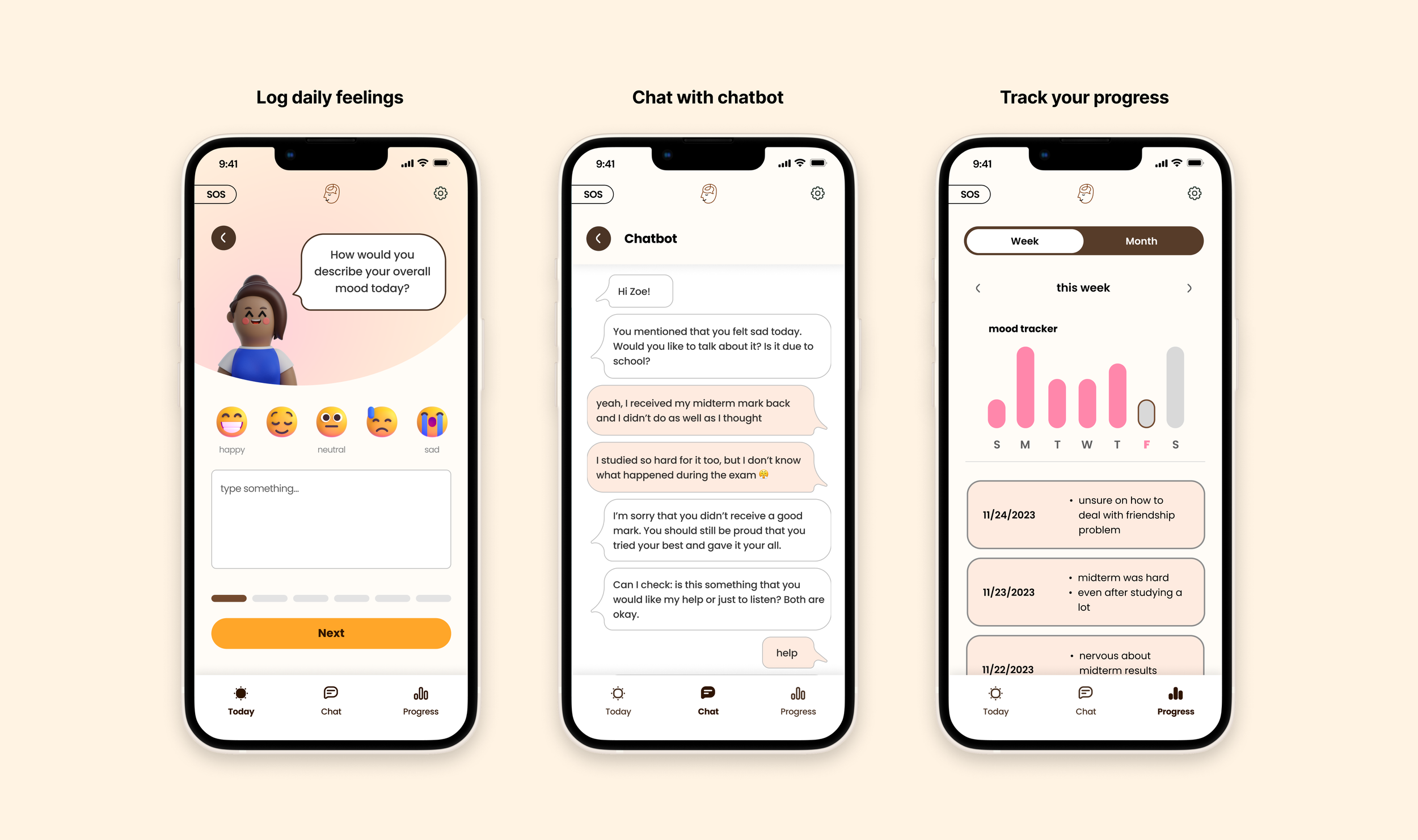Feb 2024
Increasing accessible support for students struggling with their mental health

Overview
Accessibility in mental health apps is crucial to breaking down barriers to support and ensuring that individuals from all walks of life can access the help they need. That's why I'm excited to present my case study on NuMind—an innovative app designed to empower users on their mental wellness journey. Through this project, I aim to demonstrate the importance of accessibility in mental health using technology and showcase how NuMind's features are revolutionizing the way we approach mental wellness.
At A Glance
Team
Duration
Sheffield Wong
Nancy Zheng
48 hours
My Role
I contributed to the overall design process and oversaw aspects related to product scoping, user flows, wireframes, rapid prototyping, and usability testing.
Additionally, I conducted user research, facilitated co-workshops, and contributed in synthesising research findings to produce viable ideas.

The Challenge
How might we leverage technology to promote mental health awareness and provide accessible support for students in need?
Our Solution - NuMind
Progress made with every word.
A self-realization resource converting negative thoughts into a nurturing positive mindset.
Daily self reflection
Engaging questions to guide daily reflection
6 questions-long quiz with choices of selection or typing answers
Walks users through current feelings and stressors through self awareness
Helps users figure out the root cause of their feelings
Accessible support
Real-time encouragement and insights anytime and anywhere
Immediate assistance and guidance whenever you need it
Engage with Chatbot to help you explore more of your struggles and challenges
Work through exercises together to transform negative thoughts and emotions into positive encouragement
Personalized recommendations
Making progress on your mental health journey
Tracks user’s journey over weeks and months
Visual representation of progress serves as motivating milestones
Suggested mental health resources provided by schools and professionals based on reflection answers and conversations with Chatbot
The Process
Breaking down the problem space
In our journey to understand the complexities of student mental well-being, our mission was clear: delve deep into the why behind their struggles and uncover the most significant pain points.
We broke down the issue, examining key facets such as
academic stressors,
career uncertainties,
relationship dynamics, and
time management
Surveys with 10+ participants share that time management is a big concern
Our goal was to identify patterns and pain points that current students deal with with their mental health.
We had a total of 11 survey respondents and 2 interviews with current students.
Through our data, we found that existing tools like Notion and Google Calendar address various time management challenges.
While time management is a significant issue, it's not the root cause of student mental health struggles. Interview responses highlighted a gap in the accessibility and quality of school resources—while available, they often lacked relevance and specificity. This revelation ignited our drive to delve deeper into this new compelling problem space.
Students struggle with their mental health as existing school resources are too generalized
We decided to go back to conducting surveys and interviews to delve deeper into how students perceive and access mental health resources at school. We aimed to uncover the underlying frustrations and pinpoint why students' mental health might still suffer despite the abundance of resources provided by their schools.
Using the data we collected, we needed to streamline our findings and prioritize the main focus areas that aligned with our challenge prompt.
For students
Budget friendly
Convenient and immediate
Comfortable
We identified the main characteristics and needs of our target audience that we wanted to reflect in our design.
Using a Persona to define who we are designing for
Finding out more about user behaviour through empathy mapping
To highlight key research findings and aid in our decision making, we utilized empathy mapping. This helped us make inferences about our users based on their behaviour, prioritize where our focus laid to create pain and gain points to determine what the most important takeaways are.
And so based on the pain points, our key takeaways are:
Students struggle to process their emotions and want to feel more in control
Students don’t know what resources are available and suitable for them
Existing resources seem pointless due to them being vague and generalized
Defining the problem to focus on the struggles of the user
To better understand our objective, we crafted a problem statement:
Students try to keep their mental health in check by finding a readily available mental health resource that’s right for them, but there’s a lack of confidence in the suitability and benefit of each, ultimately leading them to avoid using resources unless it’s their last resort.
Approaching a solution based on pain points
In our brainstorming sessions, we explored many solutions to address the challenge.
Our idea centered on developing a chatbot with real-time feedback capabilities, guiding users through exercises and providing support for personal growth. This foundational tool aims to instil positive reinforcement and combat habits like anxiety.
Mapping out the user flow to prioritize seamless user experience
We then created low fidelity wireframes to map out the design of our solution.
Notable features to empower users to navigate their mental wellness journey with confidence and support
In response to identified user pain points, NuMind incorporates several notable features aimed at addressing diverse challenges and enhancing user experience. Among these features are the daily reflections tool, accessible support, and personalized recommendations.




















